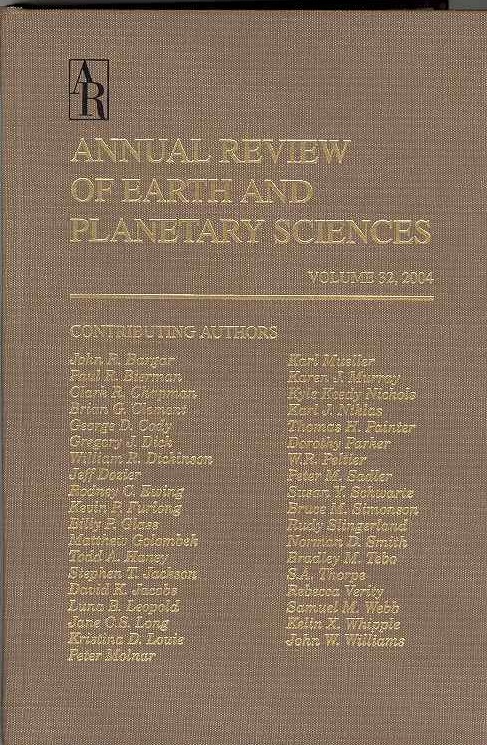从地幔中提取熔体的物理学:速度和风格
IF 13
1区 地球科学
Q1 ASTRONOMY & ASTROPHYSICS
Annual Review of Earth and Planetary Sciences
Pub Date : 2022-02-25
DOI:10.1146/annurev-earth-032320-083704
引用次数: 21
摘要
从部分熔融的地幔中提取熔体是当今和整个地质时代塑造固体地球的基本过程之一。熔体萃取的物理性质和机理各异。我们回顾了过去25年在这一领域的研究进展,重点是了解浮力驱动的熔体提取的速度和方式。对年轻熔岩u系列不平衡和冰岛去冰川火山活动激增的观测表明,与扩散多孔流动的零假设所预测的速度相比,这一速度要快得多。这种差异表明提取方式是通道化的。我们讨论了通道化如何对机械和热化学性质和反馈以及软流圈非均质性敏感。我们回顾了支撑这些特性的颗粒级物理,从而确定了更大尺度上的物理行为。然后,我们讨论了熔体提取的速度如何对预测岩浆对冰川和海平面变化的反应至关重要。最后,我们评估了当前研究的前沿,并确定了未来25年有望取得重大进展的领域。我们特别强调了熔体萃取与更现实的地幔热化学和流变性能模型的耦合。这种耦合对于理解俯冲带等复杂环境至关重要。▪地幔熔体提取塑造了今天和整个地质时代的地球。▪观测、实验室实验和理论表明,熔体通过反应通道化的多孔流动以每年约30米的速度在地幔中上升。▪海平面和冰川冰负荷的变化可能导致海底和陆上火山的融水供应发生重大变化。▪流体驱动的裂缝在岩石圈中很重要,也许在俯冲带的地幔楔中也很重要,但建模仍然是一个挑战。《地球与行星科学年度评论》第50卷的最终在线出版日期预计为2022年5月。修订后的估计数请参阅http://www.annualreviews.org/page/journal/pubdates。本文章由计算机程序翻译,如有差异,请以英文原文为准。
Physics of Melt Extraction from the Mantle: Speed and Style
Melt extraction from the partially molten mantle is among the fundamental processes shaping the solid Earth today and over geological time. A diversity of properties and mechanisms contribute to the physics of melt extraction. We review progress of the past ∼25 years of research in this area, with a focus on understanding the speed and style of buoyancy-driven melt extraction. Observations of U-series disequilibria in young lavas and the surge of deglacial volcanism in Iceland suggest this speed is rapid compared to that predicted by the null hypothesis of diffuse porous flow. The discrepancy indicates that the style of extraction is channelized. We discuss how channelization is sensitive to mechanical and thermochemical properties and feedbacks, and to asthenospheric heterogeneity. We review the grain-scale physics that underpins these properties and hence determines the physical behavior at much larger scales. We then discuss how the speed of melt extraction is crucial to predicting the magmatic response to glacial and sea-level variations. Finally, we assess the frontier of current research and identify areas where significant advances are expected over the next 25 years. In particular, we highlight the coupling of melt extraction with more realistic models of mantle thermochemistry and rheological properties. This coupling will be crucial in understanding complex settings such as subduction zones. ▪ Mantle melt extraction shapes Earth today and over geological time. ▪ Observations, lab experiments, and theory indicate that melt ascends through the mantle at speeds ∼30 m/year by reactively channelized porous flow. ▪ Variations in sea level and glacial ice loading can cause significant changes in melt supply to submarine and subaerial volcanoes. ▪ Fluid-driven fracture is important in the lithosphere and, perhaps, in the mantle wedge of subduction zones, but remains a challenge to model. Expected final online publication date for the Annual Review of Earth and Planetary Sciences, Volume 50 is May 2022. Please see http://www.annualreviews.org/page/journal/pubdates for revised estimates.
求助全文
通过发布文献求助,成功后即可免费获取论文全文。
去求助
来源期刊

Annual Review of Earth and Planetary Sciences
地学天文-地球科学综合
CiteScore
25.10
自引率
0.00%
发文量
25
期刊介绍:
Since its establishment in 1973, the Annual Review of Earth and Planetary Sciences has been dedicated to providing comprehensive coverage of advancements in the field. This esteemed publication examines various aspects of earth and planetary sciences, encompassing climate, environment, geological hazards, planet formation, and the evolution of life. To ensure wider accessibility, the latest volume of the journal has transitioned from a gated model to open access through the Subscribe to Open program by Annual Reviews. Consequently, all articles published in this volume are now available under the Creative Commons Attribution (CC BY) license.
 求助内容:
求助内容: 应助结果提醒方式:
应助结果提醒方式:


